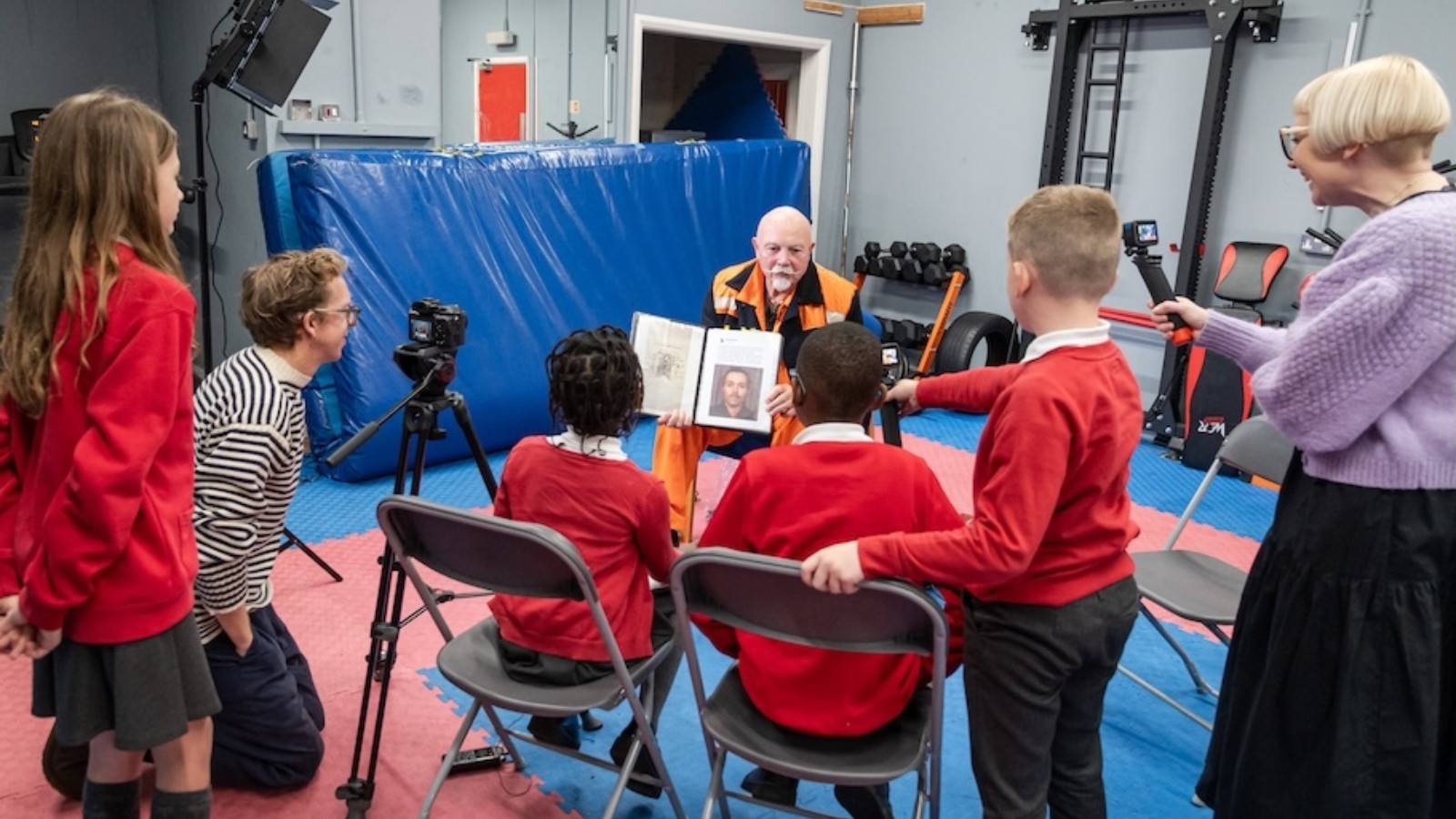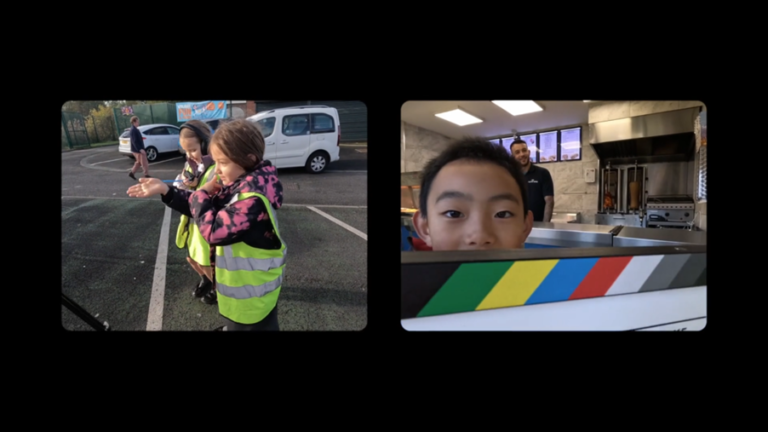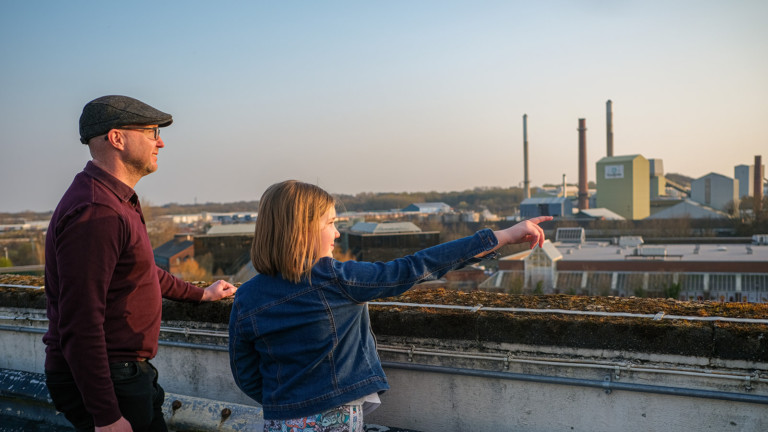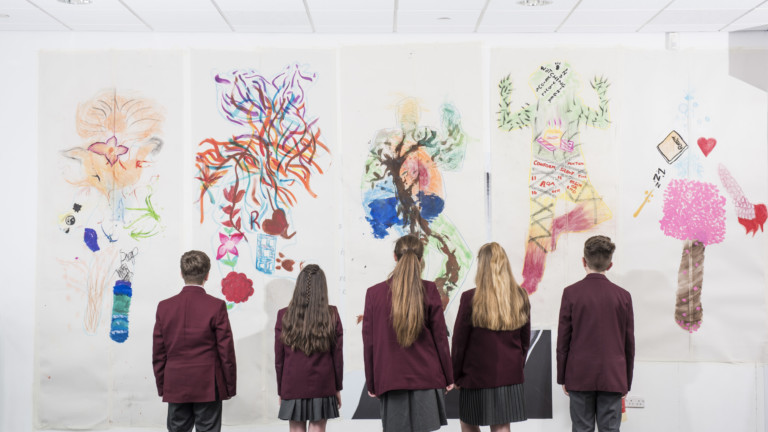1
Dolly is one hundred and one years old. I think she is the oldest person I have ever met. When Neil Armstrong landed on the moon she was already forty-six years old. She turned 60 the year I was born. When the children that were there to interview her were born she was already in her 90s.
We met Dolly at a care home in Parr in Autumn of last year. We were working with a group of 20 children from Broad Oak primary school to make a documentary about the area. As part of this we had asked them to list some of the most important places in the area – places that should feature in the film – and the care home was one of them, alongside Sankey Valley Park, the closed-down library and the corner shop opposite their school.
In the care home's break room, we frantically assembled equipment whilst the residents sat patiently like pebbles in a stream. Two of the children hovered to one side of Dolly’s armchair holding GoPro cameras and a pair of giant headphones. When either of them asked her a question she moved her head slowly towards them, like a flower turning to face the sun.
The nurses told us Dolly likes to sing, so Lola asked her to sing us a song. Dolly didn’t hear her so Lola asked again, raising her little voice like she was trying to reach out across the decades that separated them. “Sing us a song,” she said, and so Dolly started singing and we all sat and listened.
2
People experience time very differently and establishing meaningful connections across these different ways of experiencing is often difficult. To what extend are an eight-year-old and a hundred-and-one-year-old living in the same moment? What common time do they share?
The same is true I think of organisations. Establishing connections, building meaningful collaborations, is a challenge when organisations work in very different ways and to very different schedules.
Beckie and I are freelance artists, which means that we are forever trying to divide our time up project-by-project in the neatest way possible; arranging it in front of us like pieces of railway track we are constantly, frantically in the process of assembling. Yet we spend most of our time working in primary schools, where time is not something you are neatly assembling but is instead a constant churn, like a river rapid. Although you may know in theory what the shape of the year will be, in reality plans need to change daily, even hourly.
Our work also requires the collaboration of partners like Heart of Glass and funders like Arts Council England, who have their own timelines and schedules. And then there are the children themselves, for whom time never stops or slows down.
How then do we find time to work together in a meaningful way? Time that we can all inhabit?
Watch the film
3
When Beckie and I first started making work in schools over a decade ago, we structured our work differently to the way we do today. Back then a project that involved seven workshops in a primary school would unfold over seven weeks. One workshop a week, at the same agreed date and time each week. We did this because this was how the very first projects I had led for other organisations had been structured, presumably because this is how a lot things in school work – things like swimming lessons, football practice, music lessons. A weekly slot in the calendar. Another small piece in the school’s complicated matrix of activities and responsibilities, unfailingly renewing itself each new September.
It was only when we started to make work internationally that we had to change our approach. Whilst it is possible to travel to a school on the other side of this country for a couple of hours a week for seven or eight weeks in a row, it doesn’t work to run a project in Cairo or Shanghai or Auckland like this. Instead, each project had to be condensed down so that we met with our collaborators every day and could build with them an entire project in a couple of weeks of intensive work.
Immediately it became apparent that this was such a better way of working, that it was hard to believe we’d persisted with the other way for so long.
Meeting with the children every day we were able to build trust and rapport with them, to understand what was happening in their lives, to comprehend the fragile and ever-changing network of relationships between them as they existed at this very specific moment. We could also become a temporary but important part of the school community, seeing the same people every day, settling into the routines and rhythms of our environment.
We had created a little pocket of time that we could fully inhabit together. A point of meaningful connection in our otherwise very different trajectories.
4
In most cases, this brief moment of connection has remained just that. But in St Helens, thanks to Heart of Glass and Broad Oak Primary School, we have had the opportunity to try and build something else. Taking these little pockets of time together and using them to establish a more sustainable and ongoing relationship.
In 2020, in that strangely weightless moment after Covid-19 had arrived but before the announcement of a national lockdown, we first collaborated with Heart of Glass and Broad Oak creating an activist collective for under 12s – asking what capacity those children had to actually, literally change the world around them.
The following year, as Covid-19 still smouldered away around us, Broad Oak were one of three schools we worked with on the creation of The Book of St Helens. Finally, in 2022, we spent two weeks working with 16 children from Broad Oak to create a version of our project Lookout, helping them to imagine the future of St Helens. Together, we shared those imaginings with people from across the town through a series of conversations that took place on the top floor of the tallest building in the city centre, looking out across a panorama of red brick, grey slate and distant grey-green hills.
On each of these three projects we worked with a completely different group of children, had meetings with different teachers and support staff, worked in different ways, in different classrooms and with different kinds of outcomes. This remains the reality of trying to bring together people and organisations with such wildly different ways of operating in time. With different needs and expectations. Different priorities and methodologies. Ourselves, Heart of Glass and Broad Oak have all had to remain resourceful and responsive, carving out little moments to collaborate where funding, opportunity and our very different schedules have allowed.
And yet these little pockets of time have undoubtedly amounted to something more than the sum of their parts. Now when we walk into the school’s reception we recognise the faces we see there and they recognise us. There are copies of The Book of St Helens displayed on the bookshelf and a display of pictures from Lookout on the wall. These are the material traces of something more diffuse and abstract – a trust maybe or an understanding. A shared sense of when and how our time can overlap.
5
By 2023, myself and Beckie, Heart of Glass (especially producer Kate Houlton) and Broad Oak had already spent three years working together across three different projects, and now we wanted to know what might come next.
Our dream was to create one project that ran over multiple years – that would allow us as artists to work with children as they grew and changed, collaborate with teachers in a more long-term way and become even more embedded in the everyday life of the school. But the question remained: how could we bring together our very different ways of working over such an extended period, across different school years, funding cycles, financial years?
We spent some time in school talking with children, various teachers and other members of staff, and with the Heart of Glass team, and the answer we came up with together was to create a model of collaboration that was a reflection of the spontaneous, perhaps even somewhat accidental, way we had worked together over the last five years.
We would break those three years down into a series of smaller projects (the first of which was the documentary we began last autumn). We would have a core group of children from Year 4 who would follow the project throughout and they would be joined each year by children from the other year groups who would move in and out of the project as they grow older.
Each of these smaller projects we hope will be another little pocket of time we can meaningfully share together. And over three years we will string together these temporary points of connection to create something more permanent; something constant and unbroken.



 Thought
Thought Long Read
Long Read